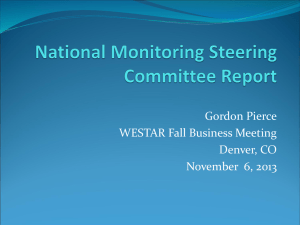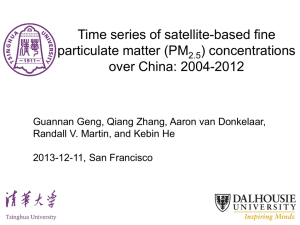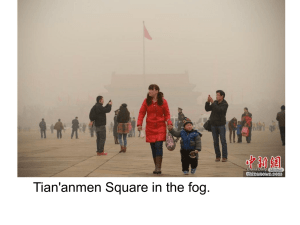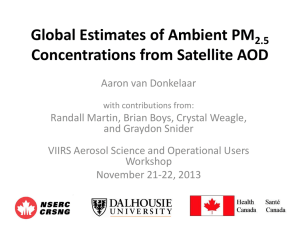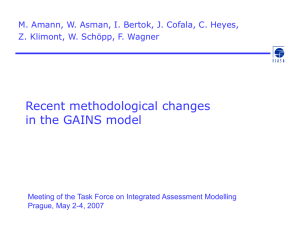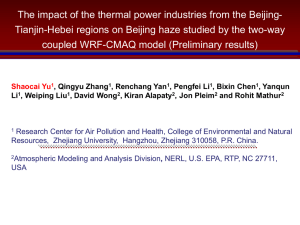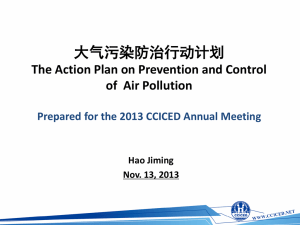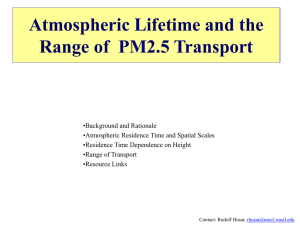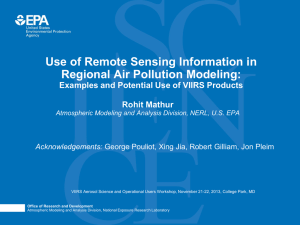Estimating Surface PM2.5 Concentrations using Satellite AOD
advertisement
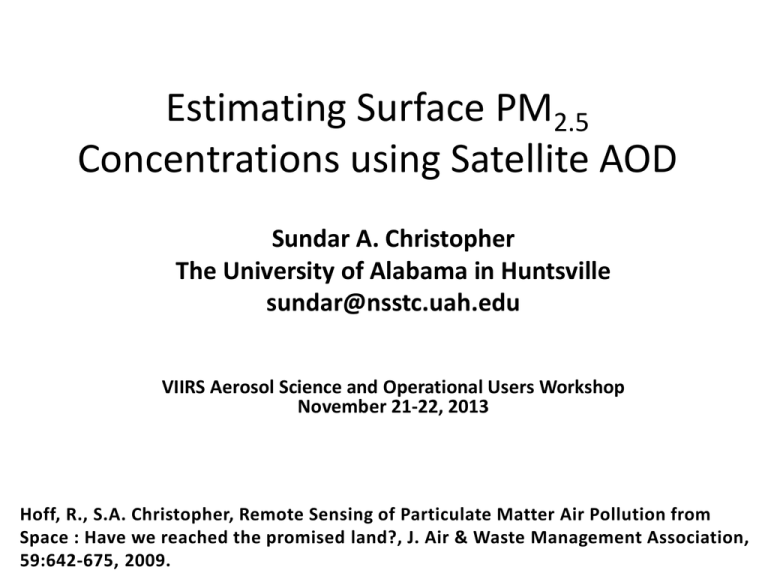
Estimating Surface PM2.5 Concentrations using Satellite AOD Sundar A. Christopher The University of Alabama in Huntsville sundar@nsstc.uah.edu VIIRS Aerosol Science and Operational Users Workshop November 21-22, 2013 Hoff, R., S.A. Christopher, Remote Sensing of Particulate Matter Air Pollution from Space : Have we reached the promised land?, J. Air & Waste Management Association, 59:642-675, 2009. What is PM2.5? • Particles < 2.5µm in diameter – ‘Fine Particles’ • All types of combustion – examples : motor vehicles, power plants, forest/agricultural burning, Why study PM2.5? 1996-1998 Fine Mass Premature Mortality Risk Huntsville Alabama Paciorek/ Hu/Al-Hamdan NAAQS: 35 mg/m3 (24 h), 15 mg/m3 (annual) U.S. Air Quality Guidelines Index Values Category Cautionary Statements PM2.5 (ug/m3) PM10 (ug/m3) 0-50 Good None 0-15.4 0-54 51-100 Moderate Unusually sensitive people should consider reducing prolonged or heavy exertion 15.5-40.4 55-154 101-150 Unhealthy for Sensitive Groups Sensitive groups should reduce prolonged or heavy exertion 40.5-65.4 155-254 151-200 Unhealthy Sensitive groups should avoid prolonged or heavy exertion; everyone else should reduce prolonged or heavy exertion 65.5-150.4 255-354 201-300 Very Unhealthy Sensitive groups should avoid all physical activity outdoors; everyone else should avoid prolonged or heavy exertion 150.5-250.4 355-424 WHO - Guidelines 24-Hour Av PM2.5 (μgm-3) Interim Target-1 (IT-1) Interim Target-2 (IT-2) Interim Target-3 (IT-3) Air Quality Guideline (AQG) Basis for the selected level 75 Based on published risk coefficients from multi-centre studies and meta-analyses (~ 5% increase of short-term mortality over the AQG value). 50 Based on published risk coefficients from multi-centre studies and meta-analyses (about 2.5% increase of short-term mortality over the AQG value). 37.5 Based on published risk coefficients from multi-centre studies and meta-analyses (about 1.2% increase in short-term mortality over the AQG value). 25 Based on the relationship between 24hour and annual PM2.5 levels. Annual Average PM2.5 (μg m3) 35 Basis for the selected level These levels are associated with about a 15% higher long-term mortality risk relative to the AQG level. 25 In addition to other health benefits, these levels lower the risk of premature mortality by approximately 6% [2–11%] relative to the IT-1 level. 15 In addition to other health benefits, these levels reduce the mortality risk by approximately 6% [2-11%] relative to the IT-2 level. 10 These are the lowest levels at which total, cardiopulmonary and lung cancer mortality have been shown to increase with more than 95% confidence in response to long-term exposure to PM2.5 NAAQS: 35 mg/m3 (24 h), 15 mg/m3 (annual) Surface PM2.5 mass monitors 20-30 1500 0-3 3-8 1-5 5-10 1-5 4-9 Satellite Remote Sensing SNOW CLOUDS SMOKE HAZE GLINT GLINT Engel-Cox VIIRS Example Aerosol Birmingham Alabama But what do satellites measure? • Need surface PM2.5 • Have column AOD • AOD is related to PM2.5 but need ancillary information AOD PM 2 .5 H f ( RH ) 3 Q ext , dry 4 reff AOD ext dz Satellite and ground-based data Both Level 1 RGB imagery and level 2 aerosol product information is useful Christopher, S.A., P. Gupta, U. Nair, T.A. Jones, S. Kondragunta, Y. Wu, J. Hand, X. Zhang, Satellite Remote Sensing and Mesoscale Modeling of the 2007 Florida/Georgia Fires, IEEE Journal of Selected Topics in Applied Earth Observations and Remote Sensing (JSTARS-200900020), 26, 1-13, 2009 Sept 9 Sept 10 No EPA sites MODIS fills in Sept 11 0.0 0.2 0.4 0.6 Aerosol Optical Depth Sept 12 0.8 1.0 0 10 20 30 40 50 Cloud Optical Thickness 60 70 0 15.5 40.5 65.5 150.5 PM2.5 (ug/m3) Correlating PM2.5 and AOD For the easy (relatively) cases if there is a PM-AOD relationship (linear in this case) use AOD to estimate PM2.5 Wang and Christopher, 2003 Hourly, R= 0.7;Daily, R >0.9 Wang, J., and S. A. Christopher, Intercomparison between satellite-derived aerosol optical thickness and PM2.5 mass: Implications for air quality studies, Geophys. Res. Lett., 30(21), 2095, doi:10.1029/2003GL018174, 2003 Creating AQI maps • Every pixel that is not cloud covered has an AQI value Uncertainties Uncertainty Linear Correlation Coefficient Even though clouds prevent AOD retrievals ~50% of the time, difference between ALL PM2.5 from ground and PM2.5 during time of satellite overpass is < 2ugm-3 for seasonal and yearly averages (Christopher and Gupta, 2009). Beyond the linear correlation Van Donkelaar, et al 2006 Observed PM2.5 Liu et al (2005) Predicted PM2.5 LnPM 2 .5 β 0 β 1 Season β 2 Region β 3 Location β 4 Dist β RH RH β AOT LnAOD β PBL LnPBL PBL, RH are necessary to estimate PM2.5 from columnar satellite retrievals. Correlations increase from 0.3 to 0.7. Progress Two variate methods Neural Networks MVM Multi-variate methods Y=mX + c PM2.5 PM2.5=α+ α1*AOT+ α2*TMP+ α3*HPBL+ α3*WS+ α4*RH AOT Global Estimates POLDER MODIS 1984 Fraser& Kaufman 2000 2002 Terra Aqua 2003 1st paper MISR 2004 2005 Lidar SeaWifs GOES 2006 2007 BAMS Global Review 2008 Epidemiology 2009 Critical Review 2013 VIIRS VIIRS Examples June 23, 2013 June 29, 2013 June 26, 2013 Summary • Satellite data continue to be useful to monitor air pollution • With ancillary data sets, satellite AOD can be used to estimate PM2.5 concentrations across the earth. Especially useful where no ground monitors are available • Awareness in other communities (e.g. epidemiology) continues to increase
